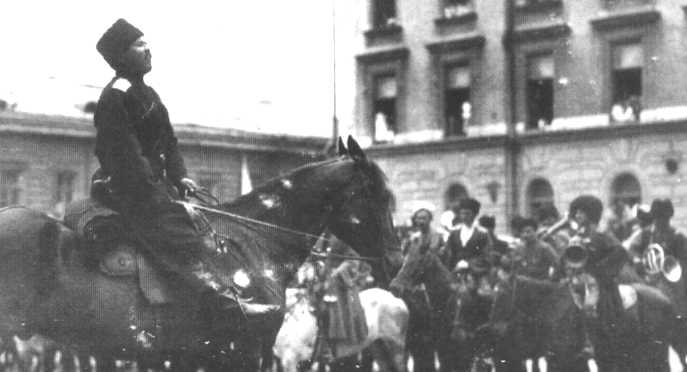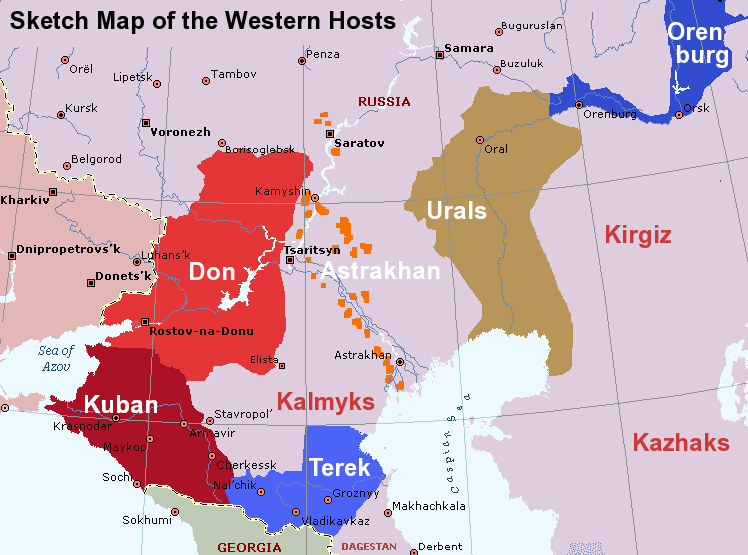
The Terek Cossack Host

Major-General Torpokov of the 1st Terek Cossack Division addressing the troops.
Note the band on horseback in the background! (Photoalbum)
The Terek Host was formed around the Terek River, running down the eastern side of the Russian Caucasus. While Cossacks had been active in the area for centuries, the actual Terek Host of Imperial Russia was not formed as such until 1860.
Uniforms
The Terek Cossacks wore a Caucasian style uniform, with their distinguishing Host colour being "pale blue".
The blue chosen by us is based on colour photos from the modern period and WWII. In practice it would greatly vary from man to man, depending on the material he chose and how faded it was.
The men were themselves responsible for supplying the uniform, and there was no uniformity of colours or styles. The cherkeska could be any shade from pale to black and any variety of grey, brown or khaki. The papakhas and bashlyks were likewise varied in style and colour.
The following pages describe the uniforms for each branch and a separate page of period and re-enactor photos.
A Multi-Sided Conflict

The Terek Host area includes Chechnya, Ingushetia, Ossetia, Karbardino and much of Dagestan, and the Host basically existed in opposition to these unruly and warlike tribesmen from the start. The mountaineers resented the favoured position that the Cossacks had gained at their expense under Tsarist rule, especially as the Terek became a wealthy area due to the local oil industry.
With the collapse of the Tsarist regime, the conflict between the Terek Cossacks and the mountaineers was almost inevitable. Raids and counter-raids started almost immediately.
At the same time there were a lot of soldiers passing back through the area from the Turkish front. They, together with a few committed Terek Cossacks, set up a local Terek Soviet Republic. Because the local Host was so wealthy, however, support for the Soviets was limited mostly to the cities, especially Vladikavkaz and Grozny. A similar Soviet Republic was set up in Dagestan. Many mountaineers initially sided with the Reds because they shared violent opposition to Cossack privileges, but the alliance was never going to last once the mountaineers became aware their religion and way of life was anathema to the Soviets.
The Terek Cossacks fought back, aided by the arrival in Dagestan of Bicherov's Cossacks transported by Dunsterville to the Baku area, but were unable to impose themselves successfully.
However the Volunteer Army's "Second Kuban March" changed the situation radically, with Denikin sweeping the area clean of Soviet groups and forcing all the anti-Bolshevik ones into his army. However the terrain was hospitable to partisan groups, and Greens and Red-Greens remained.
As a result of Denikin's campaign, the Terek was incorporated into the White zone until basically the end of the Civil War. Unlike the Kuban, the Terek was to cause the AFSR very little grief politically, which meant that Terek units could be distributed freely by the AFSR command – although most remained on the right hand side of the White's front lines in specifically Terek brigades.
But while the Terek supplied quite a few units to the White army, the distance to the main front in late 1919 resulted in far less recruitment than Denikin wanted. The Cossacks continued to fight the Moslem tribesmen from the mountains even as both sides fought in the White army.
With the collapse and retreat of the AFSR, most Terek Cossacks returned to their homes if they could. The Soviets dealt with them fairly swiftly, and the Host was suppressed. Only enough Terek Cossacks stayed with the main White armies to form a couple of regiments in the Crimea in 1920.